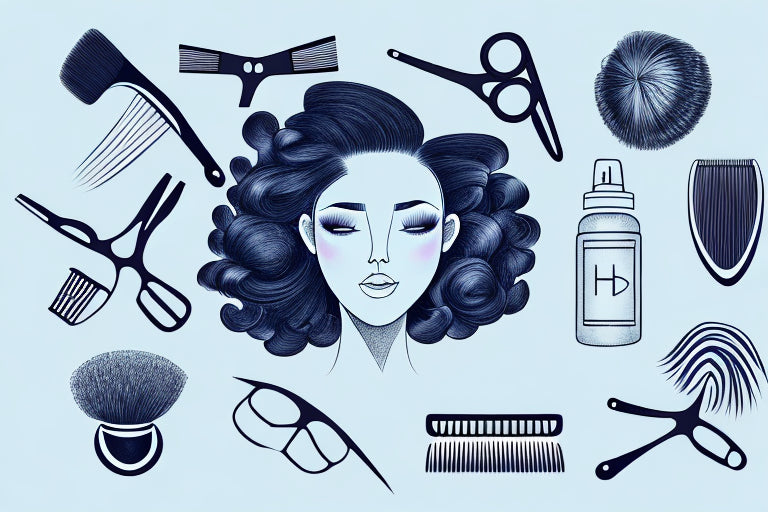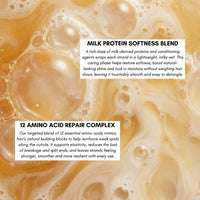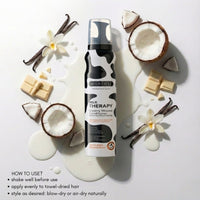Discover the Perfect Morning Hair Routine for You
Posted by MORFOSE COSMETICS

Discover the Perfect Morning Hair Routine for You
Your morning routine sets the tone for the day ahead. It's a time for self-care and preparation - a chance to start your day feeling refreshed and confident. But do you have a morning hair routine in place? If not, it's time to discover the perfect routine for you. With a little guidance and some experimentation, you can create a custom hair care regimen that ensures your locks always look and feel their best. Let's get started.
Understanding Your Hair Type
The first step in creating a morning hair routine is to understand your hair type. There are three primary hair types: straight, wavy, and curly. Each type has unique needs when it comes to cleansing, conditioning, and styling. Let's take a closer look:
Straight Hair
Straight hair is characterized by its sleek, smooth appearance. It tends to be shiny and reflects light well. However, it can also be prone to oiliness, as the natural oils from the scalp can easily travel down the hair shaft. If you have straight hair, you may want to consider using a clarifying shampoo to remove excess oil buildup.
Wavy Hair
Wavy hair has a slight bend or curve to it, but not enough to be considered curly. It can range from loose waves to more defined S-shaped waves. Wavy hair tends to be more prone to frizz than straight hair, so using a leave-in conditioner or anti-frizz serum can help tame flyaways.
Curly Hair
Curly hair has a distinct spiral or ringlet shape. It can range from loose curls to tight coils. Curly hair tends to be more dry and prone to breakage than straight or wavy hair, as the natural oils from the scalp have a harder time traveling down the hair shaft. If you have curly hair, consider using a moisturizing shampoo and conditioner to help keep your curls hydrated.
Identifying Your Hair Texture
Texture refers to the thickness of each individual strand of hair. Generally, there are three textures: fine, medium, and coarse. You can determine your texture by taking a single strand and running your fingers along it. If you can barely feel the hair, you likely have fine texture. If you can feel it, but it's not overly noticeable, you may have medium texture. And if the hair feels thick and heavy, you probably have coarse texture.
Fine hair tends to be more delicate and prone to breakage, while coarse hair can be more resistant to styling and may require more product to achieve desired results. Medium texture hair falls somewhere in between, and can be more versatile in terms of styling options.
Determining Your Hair's Porosity
Porosity refers to how easily your hair absorbs and retains moisture. If your hair has high porosity, it means it absorbs water quickly, but also loses moisture just as fast. Low porosity hair, on the other hand, is more resistant to moisture absorption. You can determine your hair's porosity by doing a simple test: take a strand of hair and place it in a bowl of water. If it sinks quickly, you have high porosity hair. If it floats, you have low porosity hair.
If you have high porosity hair, it's important to use a moisturizing shampoo and conditioner to help keep your hair hydrated. You may also want to consider using a leave-in conditioner or hair oil to help seal in moisture. If you have low porosity hair, you may need to use lighter products that won't weigh your hair down, and consider using a hair steamer or warm towel to help open up your hair cuticles and allow for better product absorption.
Assessing Your Scalp Condition
The health of your scalp is just as important as the health of your hair. A dry, itchy scalp can lead to flakes and hair breakage. A healthy scalp, on the other hand, promotes hair growth and shine. Take a moment to assess the condition of your scalp. Is it dry or oily? Are there any flaky patches? If so, you may need to adjust your hair care routine accordingly.
If you have a dry scalp, consider using a moisturizing shampoo and conditioner, and avoid using hot water when washing your hair. You may also want to use a scalp treatment or oil to help soothe and hydrate your scalp. If you have an oily scalp, consider using a clarifying shampoo to help remove excess oil buildup, and avoid using heavy styling products that can weigh your hair down and make your scalp even oilier.
Remember, understanding your hair type, texture, porosity, and scalp condition is key to creating a hair care routine that works for you. Experiment with different products and techniques until you find what works best for your hair.
The Importance of a Morning Hair Routine
Now that you understand your hair type and texture, it's time to discuss the importance of a morning hair routine.
Benefits of a Consistent Hair Care Regimen
Consistency is key when it comes to hair care. Regular cleansing, conditioning, and styling ensures that your hair is healthy and looks its best. By establishing a morning hair routine, you're setting aside time every day to care for your locks. This consistency promotes healthy hair growth and prevents damage from occurring.
When it comes to your hair, it's important to remember that it's a reflection of your overall health. A consistent hair care regimen can help keep your hair healthy and strong, which in turn can boost your confidence and self-esteem.
Furthermore, a consistent hair care regimen can also help prevent common hair problems such as split ends, breakage, and hair loss. By taking the time to care for your hair every morning, you're investing in its long-term health and beauty.
How a Morning Routine Sets the Tone for Your Day
Establishing a morning hair routine not only benefits your hair, but also your overall wellness. Taking the time to care for yourself in the morning can boost your mood and confidence. When your hair looks and feels good, you're more likely to feel ready to take on the day ahead with confidence and positivity.
In fact, studies have shown that a consistent morning routine can have a positive impact on mental health. By starting your day with a self-care ritual, such as a morning hair routine, you're setting a positive tone for the rest of your day.
Additionally, a morning hair routine can be a relaxing and enjoyable way to start your day. Taking a few extra minutes to pamper yourself and care for your hair can be a great way to reduce stress and set a calm and peaceful tone for your day.
Overall, establishing a morning hair routine is an important step in promoting healthy hair and overall wellness. By investing in your hair's health and beauty, you're also investing in your own self-care and mental wellbeing.
Essential Steps for Every Hair Routine
Now that you understand why a morning hair routine is important, it's time to dive into the essential steps that should be a part of every routine. A good hair routine can make all the difference in the health and appearance of your hair. Not only can it help prevent damage and breakage, but it can also ensure that your hair looks its best every day.
Proper Hair Cleansing Techniques
Cleansing your hair is an essential step in any hair care routine. How frequently you should clean your hair depends on your hair type and personal preference. If you have oily hair, you may need to wash it every day. If you have dry hair, you may only need to wash it once or twice a week. When washing your hair, be sure to use lukewarm water and a gentle shampoo that's made for your specific hair type. Massage the shampoo into your scalp using your fingertips, being sure to lather the entire length of your hair. This will help remove any dirt, oil, and product buildup. Rinse thoroughly to ensure that all of the shampoo is removed from your hair.
It's important to note that over-washing your hair can strip it of its natural oils, which can lead to dryness and damage. If you find that your hair is becoming dry or brittle, try washing it less frequently or using a more gentle shampoo.
Conditioning for Optimal Hair Health
Conditioner is key to keeping your hair healthy and looking its best. After shampooing, apply conditioner to the mid-lengths and ends of your hair. Leave the conditioner in for a few minutes before rinsing thoroughly. This will help to hydrate and nourish your hair, leaving it soft and shiny.
If you have high porosity hair, consider using a deep conditioning treatment once a week. This can help to repair any damage and prevent further breakage. Simply apply the deep conditioner to your hair, focusing on the ends, and leave it in for 10-15 minutes before rinsing thoroughly.
Detangling and Brushing Methods
Before styling your hair, it's important to gently detangle it. Use a wide-tooth comb or a detangling brush to remove any knots or tangles. Start at the ends of your hair and work your way up to the roots, being careful not to pull or tug on your hair. If you have curly or wavy hair, consider using your fingers to detangle instead of a brush. This can help prevent damage and breakage.
When it comes to brushing your hair, it's important to use a brush that's appropriate for your hair type. If you have fine hair, use a soft-bristled brush to avoid damaging your hair. If you have thick hair, you may need a brush with stiffer bristles to help detangle and smooth your hair.
The Role of Hair Styling Products
Styling products are essential for maintaining the health and appearance of your hair. Depending on your hair type and desired style, you may need to use different products. For example, if you have curly hair, you may want to use a curl-defining cream. If you have straight hair, a smoothing serum may be more appropriate.
Always use products sparingly, and be sure to evenly distribute them throughout your hair. This will help to prevent any product buildup, which can lead to dullness and greasiness. When applying styling products, start at the ends of your hair and work your way up to the roots. This will help to ensure that the product is evenly distributed throughout your hair.
By following these essential steps, you can create a hair care routine that will keep your hair looking and feeling its best. Remember, healthy hair starts with a good routine!
Customizing Your Morning Hair Routine
Now that you understand the essential steps of a morning hair routine, it's time to customize your routine based on your hair type and personal preference.
Tailoring Your Routine for Curly Hair
If you have curly hair, your routine may involve additional steps. Consider using a co-wash instead of shampooing every day to help prevent your curls from drying out. Use a leave-in conditioner to help lock in moisture and keep your curls defined. And don't be afraid to experiment with different styling products to find what works best for your curls.
Adapting Your Routine for Straight Hair
If you have straight hair, your routine may involve more frequent washing to keep oil buildup at bay. Use a lightweight conditioner and avoid heavy styling products that can weigh down your hair. Consider using a dry shampoo in between washes to help refresh your locks and keep them looking their best.
Adjusting Your Routine for Wavy Hair
If you have wavy hair, your routine may involve a combination of techniques for both curly and straight hair. Use a shampoo that's gentle enough for daily use, and follow up with a lightweight conditioner. Experiment with different styling products to keep your waves defined but not weighed down.
Special Considerations for Color-Treated Hair
If you have color-treated hair, it's important to choose hair care products that are specifically designed for colored hair. These products can help extend the life of your color and prevent it from fading. Consider using a hair mask once a week to help keep your locks looking vibrant and healthy.
In Conclusion
A morning hair routine can do wonders for your hair and overall well-being. By understanding your hair type, texture, and porosity, and by following the essential steps and customization tips outlined above, you can create a custom routine that ensures your locks always look and feel their best. So, take some time for yourself in the morning, and discover the perfect routine for you.



